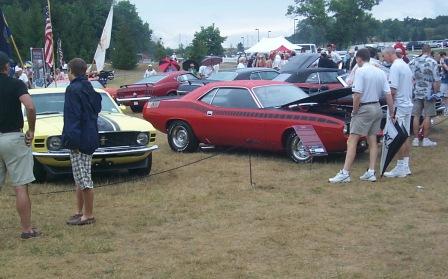
James M. Flammang, author of 30 books (including
six for children), is at work on several more,
including the title described below.
An independent journalist since the 1980s, Flammang
specialized in the automobile business. During
2016, he turned away from cars and into more vital
topics: work/labor, consumer concerns, and especially,
the emerging outrages of the Trump administration. His
website, Tirekicking Today (tirekick.com) has been
online since 1995.
Steering Toward Oblivion
The Automotive Assault on American Culture
by James M. Flammang
American car culture began to take hold in the 1950s,
escalating in the 1960s "muscle car" era. High-performance
cars continue to entice crowds at today's car shows
Overview and Summary
Economic upheaval that began in 2008 and stretched into the following year, just as a new Administration assumed the Presidency, sparked new interest in the automobile business. When the three CEOs of Detroit automakers flew to Washington D.C. in their private jets, ready to plead for government assistance to help them through the developing crisis, public reaction took many by surprise. People who had previously paid little attention to the auto industry suddenly took notice–and most of them didn't like what they saw.
In particular, GM's CEO, Rick Wagoner, brought the plight of General Motors to the forefront. Allegations of shortsighted upper management and a corporate culture that ignored the altering reality of the marketplace had been directed at GM for years–actually, for decades. Now, the corporation that had been the biggest in the world was faltering, and Americans weren't so enthused about providing government funds to attempt to "bail them out."
Auto-company titans who had in the past been hailed as virtual heroes in the industry, and among much of the general public, suddenly were perceived more as villains. The initial Wall Street "bailout" that took place in fall 2008, before the Bush Administration ended, paved the way for public anger. Soon after President Obama took office, the "Big 3" domestic automakers–especially GM and Chrysler–became prime focal points for the entire global financial crisis.
Once Chrysler and GM got their bailout money, each company began a reorganization to accompany bankruptcy proceedings. Ford chose to go its own way. Industry critics began to call GM "Government Motors," because the corporation ws now under the control of federal authorities–at least for a while. They conveniently ignored the fact that those CEOs had come to Washington pleading for funds. No one compelled them to accept any. Instead, those insider critics made it sound as if the Obama Administration had forced its way into GM's board room to take over the management.
GM dropped several of its brands, as part of a program to downsize into a leaner corporation. That's the theory, anyway–though by 2011, some observers wondered if GM executives truly got the message, and haven't largely begun to revert to their old ways.
Chrysler, which had the least stimulating product portfolio (except for minivans and Jeeps), along with a continuing reputation for quality problems, embarked upon a revitalization that included major reworking of each existing model. Corporate executives heralded the "new" models as stunning and vastly improved all around, miles ahead of their predecessors. Not every critic and reviewer has agreed that the changes were quite as dramatic as claimed.
Perhaps most notable was Chrysler's newfound tie with Fiat of Italy, leading to the release of the highly-praised Fiat 500 microcar in the United States market, in early 2011. Additional Fiat-based products are expected to follow.
Financial woes at GM and Chrysler were just the beginning of an overall auto-industry dilemma. As a result of the serious recession that began during 2008, car sales in the U.S. took a deep nosedive in 2009, falling further yet the next year. Just as sales began to rise again, in early 2011, the massive earthquake hit Japan. In addition to unimaginable human devastation, the earthquake and subsequent threat of nuclear radiation caused Japanese automakers to halt production for extended periods. Within a few weeks, the impact of curtailed Japanese production was reaching dealerships in the U.S.
Critics abound today, as a result of the crisis that presumably began in 2008. But many of those in the media and the analyst community stood largely silent through all those years of infatuation with big SUVs, minimal concern for fuel economy and emissions, and disdain for civil behavior on the road.
Auto-company problems date back for decades. The decision to force Rick Wagoner out of his CEO seat, in spring 2009, wasn't due to the current woes, but to long-standing GM decisions and practices–and the reluctance to face the changes that were taking place in the automotive world, outside Detroit, for year upon year.
In the 1950s and '60s, several noted social critics - including John Keats and Vance Packard - struggled to point out the absurdities and dangers of the expanding consumer culture and the blossoming automobile-based society. By the 1970s, their voices began to fade away. Only the more strident anti-car zealots kept up the fight, and even their diatribes grew faint with the passing of time.
Long before the 20th century ended, the car had become such an integral part of the American experience that few journalists and analysts even deigned to question the basic nature of the automotive culture. Oh, a handful occasionally acted like actual critics, finding fault with big gas-guzzling SUVs or decrying the meager steps taken toward alternative fuels and meeting stringent pollution requirements. Auto journalists commonly picked apart the merits and demerits of specific vehicle models, while financial analysts mulled the declining fortunes - financial and otherwise - of such behemoths as General Motors and the Ford Motor Company.
What was missing was the big picture. Nobody stood back far enough to take a long, close look at what the automobile had done to American - and global - culture. Perhaps more important, no one appeared to wonder why so many of us let that metamorphosis take place with barely a whimper of protest.
As the auto industry - especially the American automakers - suddenly faced financial turmoil and potential collapse in late 2008, pundits, politicians, and ordinary citizens alike wondered what had happened. How could mighty corporations fall so far, so fast, to the point of requesting a "bailout" consisting of government-guaranteed loans? Was it the result of the overall financial debacle that struck during that year? Were the auto-company executives responsible? What about the assembly workers? Could the media be blamed? The government? What role did customers themselves play?
Steering Toward Oblivion scrutinizes the car culture and auto business over the past half century, and concludes that the descent had been building up for years - indeed, for decades. Assessing the blame, we come up with a sizable list of culprits, led by the Detroit 3 CEOs and their minions, but stretching all the way to Sam and Sally Shopper, and to the car-crazed journalists who cover the automobile world.
Because most of us love our cars so much, we tend to shun criticism that might indict ourselves as well as our machines. Yet, part of the blame for our infatuation with the automobile falls at our own doorsteps, not just on manufacturers, marketers, and the media.
This book strives to show how we were hoodwinked - largely willingly - by the auto industry and its cadre of apologists, and how we we've been taken in by shapely fenders and pulsating motors, and swayed by acceleration figures and frivolous conveniences. Reaching even further, I will demonstrate that the automobile has virtually stolen the very soul of American culture not merely polluted our air, clogged our highways, and turned so many of us into perpetual debtors, dreadful as those specific acts might be.
These chapters also chronicle the swiftly-growing misbehavior on America's - and the world's - roadways. Our excessive and unruly usage of the automobile has made us a nation of lawbreakers: citizen-speeders who serve as regrettable role models for the next generations. Among other unfortunate choices, we've allowed the automobile to become a rite of passage for teenagers - one that keeps all too many drivers in their middle years in a state of perpetual adolescence, falling under the spell of speed and risky behavior.
This comprehensive yet lighthearted dissection of the automobile business and culture is sparked largely by my experiences and observations as a journalist covering the auto industry since the mid-1980s. Background for this analysis emanates from my secondary role as a historian, having written two dozen books on automotive history.
Steering Toward Oblivion will be written with a light touch throughout, for two reasons. First, I prefer to write it using humor and obliquely caustic observations rather than stern rebukes, believing that's the way to ensure that its message will be heard. Secondly, I want the book to be read by as many people as possible, including enthusiasts and those in the auto business. A heavy dose of indignant, somber criticism would never accomplish that goal.
Unlike many social critics - past and present - I've learned to stand back and laugh a bit at the absurdity of what we've done. My model is not the anti-car diatribes that have appeared periodically. No, it's The Insolent Chariots, John Keats' 1958 best-seller. Writing with a light touch peppered by humor, chronicling the exploits of such fictional characters as dealer Simon Greed and shopper Tom Wretch, Keats delivered devastating blows against the follies of the consumer-targeted auto industry that had developed in the 1950s. If he were around today, I expect that Keats would be flabbergasted by the trajectory that the auto business has taken since his day, and by the way motorists have fallen so willingly under its spell.
Note: Some chapters, such as those describing the lavish media programs automakers have developed, don't necessarily apply fully to situation of the auto industry during the 2010s and beyond, following the 2008 financial troubles and subsequent slowdown in sales.
Click here for a Chapter Outline of Steering Toward Oblivion.
Click here for an excerpt of Chapter 1.
Click here for an excerpt of Chapter 13.